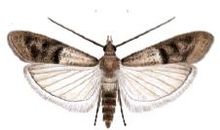Indianmeal Moth
| Indian mealmoth | |
|---|---|
 |
|
 |
|
| Scientific classification | |
| Kingdom: | Animalia |
| Phylum: | Arthropoda |
| Class: | Insecta |
| Order: | Lepidoptera |
| Family: | Pyralidae |
| Tribe: | Phycitini |
| Genus: |
Plodia Guenée, 1845 |
| Species: | P. interpunctella |
| Binomial name | |
|
Plodia interpunctella (Hübner, [1813]) |
|
| Synonyms | |
|
Many, see text |
|
Many, see text
The Indian mealmoth (Plodia interpunctella), alternatively spelled Indianmeal moth, is a pyraloid moth of the family Pyralidae. Alternative common names are weevil moth, and pantry moth; less specifically, it may be referred to as flour moth or grain moth. The almond moth (Cadra cautella) is commonly confused with the Indian mealmoth.
Its larvae (caterpillars) are commonly known as waxworms like those of its relatives, though they are not the particular waxworms often bred as animal food. They are a common grain-feeding pest found around the world, feeding on cereals and similar products.
This is, as far as is known, the only living species of the genus Plodia. It is closely related to the (doubtfully distinct) genera Cadra and Ephestia which include other pest species (e.g. E. kuehniella which is also colloquially called "flour moth").
The species has been described under a number of junior synonyms, which may occasionally still be found in nonentomological sources:
The common name for this species was coined by Asa Fitch, an entomologist employed by the state of New York in the 19th century. In a report published in 1856, Fitch discussed the species, noting the larvae infest stores of cornmeal, which was then called "Indian meal".
Adults are 8–10 mm in length with 16– to 20-mm wingspans. The outer half of their fore wings are bronze, copper, or dark gray in color, while the upper half are yellowish-gray, with a dark band at the intersection between the two. The larvae are off-white with brown heads. There are 5-7 larval instars. When these larvae mature, they are usually about 12 mm long. "They have five pairs of well developed prolegs that help them move considerable distances to pupate."[1]
...
Wikipedia
